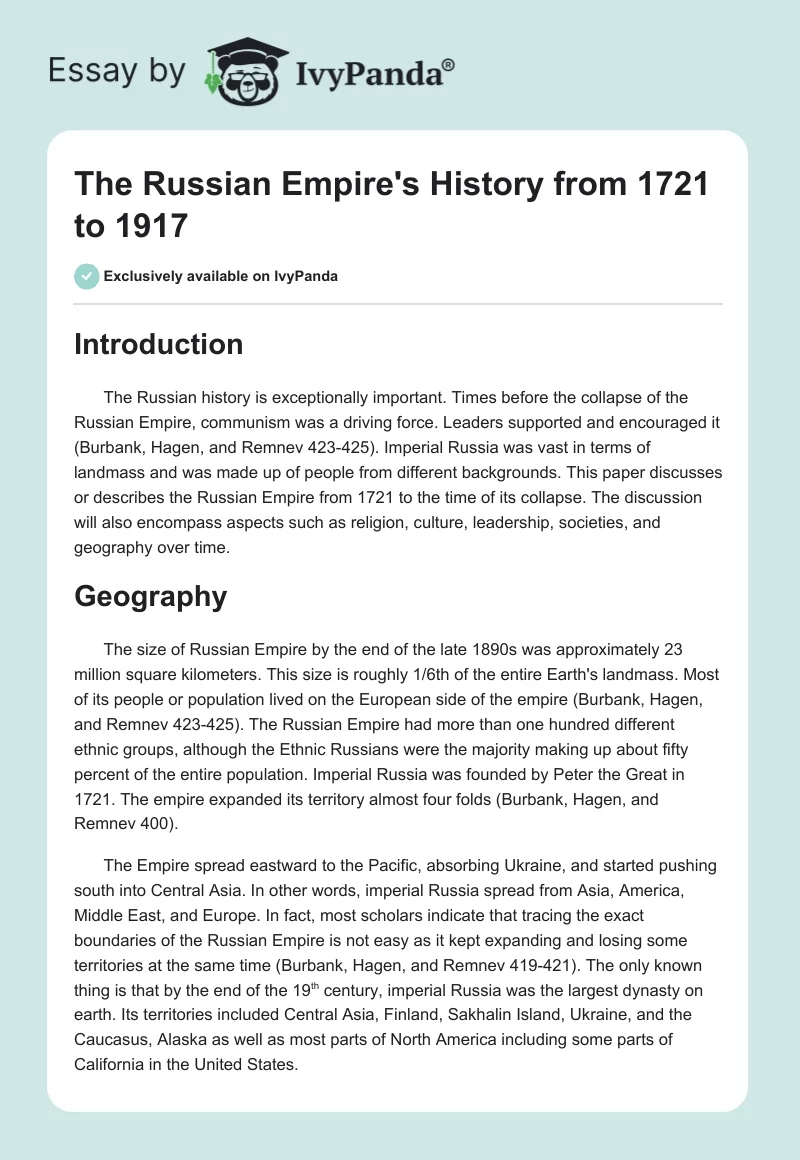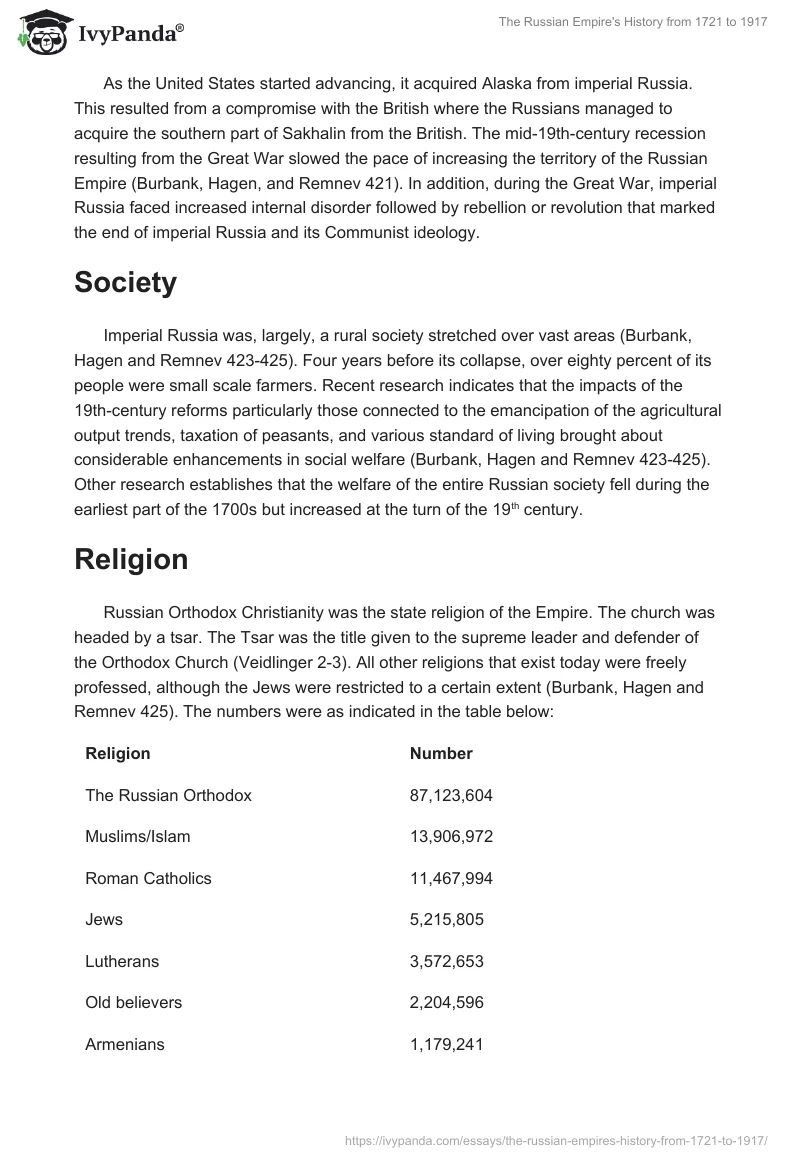Introduction
The Russian history is exceptionally important. Times before the collapse of the Russian Empire, communism was a driving force. Leaders supported and encouraged it (Burbank, Hagen, and Remnev 423-425). Imperial Russia was vast in terms of landmass and was made up of people from different backgrounds. This paper discusses or describes the Russian Empire from 1721 to the time of its collapse. The discussion will also encompass aspects such as religion, culture, leadership, societies, and geography over time.
Geography
The size of Russian Empire by the end of the late 1890s was approximately 23 million square kilometers. This size is roughly 1/6th of the entire Earth’s landmass. Most of its people or population lived on the European side of the empire (Burbank, Hagen, and Remnev 423-425). The Russian Empire had more than one hundred different ethnic groups, although the Ethnic Russians were the majority making up about fifty percent of the entire population. Imperial Russia was founded by Peter the Great in 1721. The empire expanded its territory almost four folds (Burbank, Hagen, and Remnev 400).
The Empire spread eastward to the Pacific, absorbing Ukraine, and started pushing south into Central Asia. In other words, imperial Russia spread from Asia, America, Middle East, and Europe. In fact, most scholars indicate that tracing the exact boundaries of the Russian Empire is not easy as it kept expanding and losing some territories at the same time (Burbank, Hagen, and Remnev 419-421). The only known thing is that by the end of the 19th century, imperial Russia was the largest dynasty on earth. Its territories included Central Asia, Finland, Sakhalin Island, Ukraine, and the Caucasus, Alaska as well as most parts of North America including some parts of California in the United States.
As the United States started advancing, it acquired Alaska from imperial Russia. This resulted from a compromise with the British where the Russians managed to acquire the southern part of Sakhalin from the British. The mid-19th-century recession resulting from the Great War slowed the pace of increasing the territory of the Russian Empire (Burbank, Hagen, and Remnev 421). In addition, during the Great War, imperial Russia faced increased internal disorder followed by rebellion or revolution that marked the end of imperial Russia and its Communist ideology.
Society
Imperial Russia was, largely, a rural society stretched over vast areas (Burbank, Hagen and Remnev 423-425). Four years before its collapse, over eighty percent of its people were small scale farmers. Recent research indicates that the impacts of the 19th-century reforms particularly those connected to the emancipation of the agricultural output trends, taxation of peasants, and various standard of living brought about considerable enhancements in social welfare (Burbank, Hagen and Remnev 423-425). Other research establishes that the welfare of the entire Russian society fell during the earliest part of the 1700s but increased at the turn of the 19th century.
Religion
Russian Orthodox Christianity was the state religion of the Empire. The church was headed by a tsar. The Tsar was the title given to the supreme leader and defender of the Orthodox Church (Veidlinger 2-3). All other religions that exist today were freely professed, although the Jews were restricted to a certain extent (Burbank, Hagen and Remnev 425). The numbers were as indicated in the table below:
Source: Author.
Culture
The Russian Empire was made up of a diverse population. Most of these people came from a background of mixed heritage and culture. In addition, the languages as well as tools of the Russians during the Russian empire were often associated with agriculture (Burbank, Hagen and Remnev 320-321). Thus, this emphasizes or represents their way of life at that time. The outgrowth of villages and settlement areas led to the emergence or rise of these places politically, socially and economically. This completely changed the lives of many people from countryside lifestyle to a more urban lifestyle.
As people developed from a rural kind of lifestyle, class distinction was starting to develop among the people as the returns from businesses and wealth from agricultural work was immense (Burbank, Hagen and Remnev 423-425).Russian at that time was known to be a collection of people from different ethnic backgrounds.
In the 19th century and the early times of the 20th century, demographic, legal, social, as well as economic situations of Russian Jews changed in line with the cultural and religious revolution (Burbank, Hagen and Remnev 27-34). In fact, nearly all Jews of Russian origin remained or maintained their traditions to the end of the royal era (Burbank, Hagen and Remnev 423-425). During the reign of Nicholas, Hasidism was highly adopted by most people especially the Jews in Eastern Europe. This appealed to many Jews living in Poland and Ukraine at that time. The Hasidic courts developed, and were also used as a major source of political, spiritual, as well as economic aspects.
The army
During the Russian Empire, the army was not very powerful as it is today or during the cold war. The army during this time was not even capable of defending the territory of the Empire (Burbank, Hagen and Remnev 423). The army was small and highly disorganized. People were drawn up from villages without proper instruction to make up the army. In fact, the army during that time was a collection of factory workers who were assembled whenever the need arose. The Bolsheviks were responsible for assembling the army. The army was assembled only when there was need such as defending the territories from enemies.
Social classes
People in the Russian Empire were highly segregated. That is, they were grouped into classes based on their social status in the society. Some of these classes comprised: the church leaders or the clergy, business people, and small scale farmers. Native ethic community of the Caucasus and non-ethnic Russian places like Central Asia and Siberia were registered as places of people of another origin (Burbank, Hagen and Remnev 423). Most people in the imperial Russia belonged to peasant order making up about eighty percent of the entire population, clergy or church leaders 0.1 percent; the nobility making up 0.6 percent; the merchants and burghers about nine percent and military about six percent (Burbank, Hagen and Remnev 423).
Poor Economy
For many years since it adopted communism, the Empire became poorer and poorer. The Imperial Russia relied on the returns from the ruble. It must be recognized however that its value was falling especially in the early part of the twentieth century. With a huge land mass, the resources in the imperial Russia were enormous (Burbank, Hagen and Remnev 410- 424). The difficulty of accessing these resources made it hard to exploit them for the betterment of the people. The distance between the mineral sites and processing areas was land and thus expensive to exploit such resources. Some cities and towns were founded closer to the mineral sites to ease their exploitation. But again, the proceeds were heavily channeled towards the development of the army.
Wellbeing
From 1721 even to the time of collapse, the Russian society was going through troubled times or moments. It was always bad time for the Russian empire as it was characterized by lots of inadequacies (Burbank, Hagen and Remnev 421). People used to come to power through political appeal. However most of them used to abuse it. Some emperors were hereditary that means that at times people who were not experienced including young ones assumed leadership (Veidlinger 118). Such leaders were manipulated at the expense of the general public.
Politics
Lenin supported Marxism instead of capitalism under his communist party. Marxism as an ideology was to support the employment of many workers or giving state jobs to people who supported communism. Towards the end of imperial Russia, there was a revolution under the leadership of Lenin that formally put communism into place (Burbank, Hagen and Remnev 427). Lenin inculcated the idea of communism in the Russian society not as a force and or a way of seeking dominance, but as a way of instilling discipline particularly in the forces. As a way of spreading its manifesto, members were first inculcated in the communist belief and ideas (Burbank, Hagen and Remnev 421). The party prohibited their members from self enrichment. Any member who concentrated on amassing wealth was immediately suspended from the party. The main aim of forming the communist party was to fight for the equality and working conditions of the commons.
Leadership
There were many leaders who wielded power over the imperial Russia. When closely analyzed, some leaders of the imperial Russia can be commended for their great work and others not. Peter the Great is one of the highly praised leaders. Peter the Great was the Czar of Russia from 1682 to 1721 (Burbank, Hagen and Remnev 420). He introduced some western culture into the Russian Empire an aspect people perceived as good while others had reservation with the system (Burbank, Hagen and Remnev 421). Those who had reservations with the system argued that Russia would be better off doing their own things than copying them from the outside world.
Conclusion
The imperial Russia spanned over a large land mass with its people coming from different ethnic backgrounds. Even though these people belonged to different religions, the major religions in the empire were the Russian orthodox and the Roman Catholic Church. People also had different cultures and belonged to different societies depending with the cause of the organization. Jews were the group that mostly relied on organizations and societies to express themselves and fight for their position in the Russian society.
Works Cited
Burbank, Jane, Mark Hagen and Anatolyi Remnev. Russian Empire: Space, People, Power, 1700-1930. Bloomington, IN: Indiana University Press, 2007. Print.
Veidlinger, Jeffrey. Jewish Public Culture in the Late Russian Empire. Indianapolis, IN: Indiana University Press, 2009. Print.


